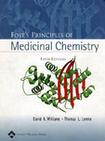Foye医药学原理Foye's Principles of Medicinal Chemistry
2002-2
Lippincott Williams & Wilkins
David A Williams
1114
This comprehensive Fifth Edition has been fully revised and updated to meet the changing curricula of medicinal chemistry courses. The new emphasis is on pharmaceutical care that focuses on the patient, and on the pharmacist a therapeutic clinical consultant, rather than chemist. Approximately 45 contributors, respected in the field of pharmacy education, augment this exhaustive reference. New to this edition are chapters with standardized formats and features, such as Case Studies, Therapeutic Actions, Drug Interactions, and more. Over 700 illustrations supplement this must-have resource. Massachusetts College of Pharmacy and Health Sciences, Boston. Textbook, for pharmacy students, now includes an overview of the drug development process from the perspective of an industrial research scientist. Also new to this edition: an overview of drug receptors, case studies, selected readings, and a companion web page. Previous edition: c1995.
Introduction Origins of Medicinal ChemistryPart Ⅰ Principles of Drug Discovery Overview Drug Design and Development: A Perspective 1. Natural Products 2. Drug Design and Relationship of Functional Groups to Pharmacologic Activity 3. Molecular Modeling and Drug Design 4. Receptors and Drug Action 5. Drug Design Through Enzyme Inhibition 6. Peptide and Protein Drugs 7. Physicochemical and Biopharmacemical Properties of Drug Substances and Pharmacokinetics 8. Drug Metabolism 9. U.S. Drug Regulation: An OverviewPart Ⅱ Pharmacodynamic Agents Overview Drug Receptors: A Perspective Section 1 Drugs Affecting Neurotransmission 10. Drugs Affecting Cholinergic Neurotransmission 11. Drugs Affecting Adrenergic Neurotransmission 12. Serotonin Receptors and Drugs Affecting Serotonergic Neurotransmission 13. Local Anesthetics Section 2 Drugs Affecting Central Nervous System 14. Volatile Anesthetics 15. Hypnotics 16. Antiseizure Drugs 17. Psychotherapeutic Drugs: Antipsychotic and Anxiolytic Agents 18. Hallucinogens, Stimulants, and Related Drugs of Abuse 19. Opioid Analgesics 20. Drugs Used to Treat Neuromuscular Disorders: Antiparkinsonian and Spasmolytic Agents Section 3 Drugs Affecting the Cardiovascular System 21. Cardiac Agents: Cardiac Glycosides, Antianginal, and Antiarrhythmic Drugs 22. Diuretics 23. Angiotensin Converting Enzyme Inhibitors, Antagonists and Calcium Blockers 24. Central and Peripheral Sympatholytics and Vasodilators ……Part Ⅲ Recent Advances in Drug DiscoveryAppendices pKa Values for Some Drugs and Miscellaneous Organic Acids and Bases pH Values for Tissue Fluids

Foye医药学原理Foye's Principles of Medicinal Chemistry PDF格式下载